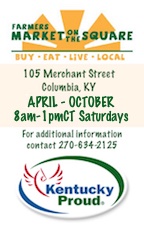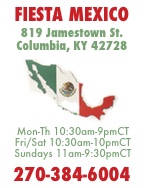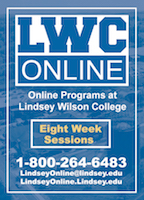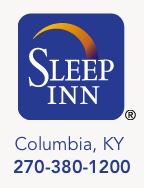| ||||||||||
Dr. Ronald P. Rogers CHIROPRACTOR Support for your body's natural healing capabilities 270-384-5554 Click here for details 


Columbia Gas Dept. GAS LEAK or GAS SMELL Contact Numbers 24 hrs/ 365 days 270-384-2006 or 9-1-1 Call before you dig Visit ColumbiaMagazine's Directory of Churches Addresses, times, phone numbers and more for churches in Adair County Find Great Stuff in ColumbiaMagazine's Classified Ads Antiques, Help Wanted, Autos, Real Estate, Legal Notices, More... 
|
JIM: The lineage of a grocery store (1903-1918) 'The lineage of a grocery store on the Square, from founding to demise, 1903-1918.' The transitions of a 15 year enterprise, which persevered through numerous ownerships, partnerships, and changes of venue, all around the Square. Should, in spite of author's acute Steerupaphobia and anti-seditiousness, some be incited to comment please do so. For the many who only read CM for JIM'S pieces, a comment would be a tiny expected courtesy for this epic essay. - ED WAGGENER With acknowledgment and grateful gratitude to JIM's acknowledgement of a leading but small fraction of his vast worldwide and polyuniversal cheering section: Ann C., Mike W. and John R. By JIM of The Great White North The lineage of a grocery store on the Square, from founding to demise, 1903-1918 (including an addendum, an abundance of asides, and numerous names dropped, all at whim of the compiler, but carefully bowdlerized of shootings and very nearly all other salacious shenanigans in order not to steer up the general populace and disturb the domestic tranquility of the Auld Sod) A hundred or so years ago, the names of businesses and the proprietors thereof oft-times changed with amazing frequency. Such was the case of a grocery store that opened on the square in the summer of 1903 and closed its doors forever in the spring of 1918 - with many a twist and turn in between, including no fewer than eight different names and nine sole or co-owners, six of whom had departed Adair County by 1920. Jackman's Store Toward the latter part of July 1903, a three-line ad appeared in a couple of editions of the Adair County News: "I have a complete line of groceries [at] the lowest cash price. Give me a call. Frank Jackman." Frank had been in business in Columbia as a jeweler since the late 1890s, most likely in the same location, before adding a line of groceries. Mr. Jackman didn't believe in overextending his advertising budget, as three years passed before he laid before the readership in July 1906 that he kept "a first-class stock of family groceries-fresh meat two or three times a week" as well as "...a large assortment of tobacco. Two twists of regular home grown for 5 cents." (In the middle of October 1906, the News announced Mr. Jackman had purchased from Mrs. Bettie Butler property adjoining the T.E. Paull drug store lot and had broken ground for a business house with "a two story front and one story in the rear." Part of the building would house Mr. Jackman's grocery store and another part would be for the saddlery shop of his brother, John W. Jackman. At the same time, S.D. Barbee bought the Tutt & Beard building "on the south-west side of the square" then occupied by the brothers Jackman; N.M. Tutt & J.P. Beard had bought the building, referred to in the News as the Griffith property, in the fall of 1902. The only other mention found of the proposed Jackman business house came in March 1907, when the News stated "On the West side of the square Mr. Frank Jackman will have a brick business house." A notice in late June 1910 stated the former Butler property would sell at the courthouse door on July 4th, but the News carried no follow-up information about the sale. Mr. Jackman and family departed for Hillsborough County, Florida, in the spring of 1911, never to return to Columbia.) Come November 1906, the News reported Mr. Jackman had gone upscale (in a manner of speaking) by adding "a 'Stimpson Computing Scale' to his store furniture." (The Stimpson, patented in the mid-1890s and named for its inventor, revolutionized grocers' scales by allowing the merchant to simultaneously weigh and price an item.) Young Bros. Almost exactly a year later, brothers R.K. and Marvin (better known as L.M.) Young, stock dealers who were natives of Cumberland County, bought Mr. Jackman's inventory of groceries and announced they would "continue the business at the same stand," and shortly thereafter, touted their "first-class stock of groceries and fresh meat" and solemnly promised "All goods delivered in town promptly." (About eighteen months later, S.D. Barbee sold to J.D. Walker "the business house on the square occupied by Young Bros. and J.W. Jackman.") Richardson's Store The brothers Young ran the grocery store for almost exactly three years before selling it to Hugh Richardson, who had removed from Cumberland County to Columbia some years earlier to engage in the livery business with the Goff Brothers, the lineage of said livery firm being more convoluted than that of the store currently under discussion. (In the forepart of 1919, Mr. R.K. Young and family removed to West Point, Miss.) Richardson & Beck Mr. Richardson maintained sole proprietorship for a few months, then sold a one-half interest in the enterprise to Cumberland County native Sam Beck toward the end of March 1911. Said the News, "The business will be conducted over the firm name of Richardson and Beck. It is not a new business for Mr. Beck, he having conducted a grocery store here for several years. The News extends best wishes to the firm, commending it to the purchasing trade." (When Mr. Beck removed to Columbia from Burkesville in early 1903, he was a traveling salesman for a wholesale outfit. Some months later he became a partner in the firm of Beck & Strange which operated in Columbia "on the Bram Vaughan corner" from October 1903 through the middle of April 1906. At that time, the Messrs. Beck and Strange sold their stock of groceries to Mr. J.F. Neat, who intended close out that line of goods and sell furniture as well as "carpets and many other household items." Come October, the News announced Mr. Beck and Mr. Neat had formed a business alliance and would add a line of groceries in addition to selling furniture. Messrs. S.W. Beck & Conrad "J.C." Strange were brothers-in-law, Mr. Strange and Mrs. Beck being brother and sister.) Beck & English Later in 1911, around the end of October or early November, Mr. Richardson departed the firm altogether, selling his remaining interest to Mr. Beck and Mr. J.A. English. (About a year later, Mr. Richardson, while driving two passengers from Louisville to Columbia, struck a buggy occupied by Mrs. Lena Ellingsworth of Louisville. Thinking he had seriously injured or perhaps killed the woman, Richardson panicked and kept driving. The car broke down near Springfield and the three men found alternate transportation to Columbia. From there, Mr. Richardson lit out on horseback toward Burkesville and upon reaching the banks of the Cumberland, left a suicide note in his hat. The note, however, was a fake, and he turned up in Columbia about 10 days later. For the record: Mrs. Ellingsworth, 40 at the time, lived another four and twenty years. In October 1914, Mr. Richardson and family removed to Campbellsville, where, announced the News. he and S.W. Beck, also known as Sam, "will engage in the grocery business." Almost exactly a year later, the Richardson family moved west and in late November 1916, resided in Augusta, Kansas. It was at that time and place that Mrs. Richardson, about 28 years old, died of complications from childbirth.) Beck & Flowers In early 1912, the News stated Ray Flowers had just purchased the half interest of Mr. J.A. English in the grocery firm of Beck & English. The article in the February 7 paper stated that Mr. Flowers, "a popular young man," was already at his place of business and that he invited his many friends to come trade with him. (Mr. James "J.A." English pursued agricultural interests for a number of years afterward. In March 1914 he was elected President of the annual Farmer's Institute for Adair County, and he served for a number of years as a trustee of the Columbia Graded School. Toward the middle of November 1919, the family took leave of Columbia to become part of the thriving Adair County colony near West Point, Miss.) Flowers & Walker In November 1914, Mr. S.W. Beck made his departure from the grocery business in Columbia and sold his interest in the firm to Mr. Nat Walker. (The Beck family removed to Campbellsville in early 1915, and by the spring of 1918, they resided in Louisville, where Mr. Beck was a salesman for a wholesale candy company. When he passed in 1923, his occupation was noted as "shipping clerk.") Flowers & Patteson Mr. Walker's tenure as a partner was as short lived as that of some of his predecessors, as the June 16, 1915 edition of the News reported he had sold his interest in the firm of Flowers & Walker to Mr. Tom Patteson. (Mr. Patteson--full name Thomas Oliver--had reached his majority a few months prior to becoming a partner in the store. On his World War I draft card, filled out in June 1917, he stated he had a "curved spine and bad side." His name appeared on the 1920 Adair Country census, but his occupation was noted as being that of a time clerk in an automobile factory, an unlikely position for Columbia.) (Just days before Mr. Walker bowed out, the firm of Flowers & Walker fell victim to a burglar. On Friday night, June 11th, or in the wee hours of Saturday, June 12th, someone entered the premises by way of a basement window. Getting right down to the brass tacks, the News reported that "The cash drawer was tapped and three dollars in change [was] taken." The proprietors were unable to determine if any merchandise were taken.) In the summer of 1917, the Messrs. Flowers & Patteson, both young men, placed a tersely worded announcement in the paper, stating effective August 1st (the day the notice appeared) they would "sell goods for cash or produce only" because "The war is on and we may have to go to the front." In September 1917, Mr. Flowers took leave of Columbia for Frederick, Oklahoma to work in "a large mercantile store" operated by Adair County native Porter A. Strange. His return to Adair County the following February was precipitated at least in part by the anticipation of being called to the army. Flowers & Patteson ceased to be in the summer of 1918. The July 31 issue of the paper informed readers the owners were "selling out their stock of goods" with the intention of quitting the business because "Mr. Flowers has joined the colors, and Mr. Patteson will seek business elsewhere." The same edition of the paper reported that Mr. Patteson and four other Adair Countians had been accepted for limited military service the previous week and had left on Tuesday, July 30th, for Syracuse, New York. The following week came the news that Tom Patteson and Alvin Lewis had been called to "enter the service of the government" and that they were "to report in Indianapolis August 15, for automobile duty." (The May 14, 1919 News informed readers Mr. Flowers had "accepted a position as salesman in the store of Rhodes, Rapier, & Co., of Louisville." He was among the 1920 census takers of Adair County, and later served as the Columbia postmaster for several years. According to a kinsman, Mr. Patteson later served as a Treasury Agent -- pronounced "revenoor" in Adair County -- and as the police chief of Lebanon, Ky.) Flowers & Patteson and their predecessors sold groceries and general household items, as ads appeared at various times for such things as self-rising flower, candles, soap (and, of course, chewing tobacco, as earlier noted). An announcement in the June 4, 1919 paper stated E.L. Sinclair's new dry goods store was located "in the Flowers & Patteson old stand...between Nell & Cheatham and C.R. Hutchison." That places the location between Burkesville Street and the west corner of the Square. All of the frame buildingsd on that part of the square were destroyed by the Great Conflagration of 1921. An addendum (to complete the cycle and circle the Square) In September 1909, John W. Jackman, brother of Frank and whose place of business was in the same building as the grocery store under discussion, placed this ad in the newspaper: "On account of declining health, I desire to sell my stock of groceries, hardware, saddlery and harness business. The place I occupy is on the square, a good location. /s/ J.W. Jackman, Columbia, Ky." Hardly had the ink dried on that edition of the newspaper before the operation was purchased by Mr. C.R. Hutchison purchased the operation and placed a notice of his own in a late October edition: "I have purchased the stock of groceries, harness, hardware and saddlery lately owned by J.W. Jackman and will continue the business in the same stand, If you are in need of fresh groceries or any thing in my line, call and see me." /s/ C.R. Hutchison." An ad in spring of 1910 advised readers that in addition to a "good line of family groceries," Mr. Hutchison also carried farm implements, including McCormack mowers and reapers and "genuine Brown cultivators" as well as "saddles, bridles and harnesses," and noted that harness repair was also offered. In the summer of 1917, Mr. J.O. Russell, whose second wife--the former Kizzie Murrell, nee Walker-- had recently died, offered for sale at the courthouse door a number of properties in which the late Mrs. Russell had owned an interest. Included in the list was "one-half interest in frame store houses on southwest side of public square now occupied by Flowers & Patterson and C.R. Hutcherson (sic)." (John Lee Walker, Kizzie's nephew, purchased all the properties for $8,000 and immediately "transferred the same to J.O. Russell." Almost certainly, Mr. Russell already owned the remaining interests in the properties.) Two years later, Mr. Hutchison formed a partnership with A.D. Patteson (Tom's uncle and J.O. Russell's nephew) and the announcement was brought forth before the public in the July 2, 1919 News. The partnership was to continue business in the same place Mr. Hutchison had been located since purchasing the J.W. Jackman shop a decade earlier. Apparently, Mr. Hutchison had purchased the building and lot by this time, as three weeks later it was revealed they "likely will raze the building they are now doing business in and it will be replaced by a two story brick." The article went on to state that "When this improvement is made every building in that block, from the Bank of Columbia to the West corner, will be brick." However, for reasons long since forgotten, the proposed edifice never came to fruition, and in late September 1921, the Great Conflagration on the Square wiped out the Bank of Columbia building, the (W.L., later Tola) Walker Building, and the Hutchison & Patteson frame building. (The article in the News about the devastating fire noted the latter structure was "located between the Walker building and the Paull Drug Co. business house and separated from the latter by a narrow vacant lot." In the fall of 1922, Fred Hill had a building put up on the narrow lot; it housed Mont Maupin's barber shop for a number of years.) The business held on for a while, with Mr. Hutchison trying to sell groceries from a corner room in the Jeffries Hotel, and the January 10, 1922 newspaper stated that Mr. Hutchison had the intention to "rebuild on his site, on the public square, as soon as winter is over." However, only ten days later, on Saturday, January 20, 1922, the Bank of Columbia bought the Hutchison lot (consideration, $4,250); almost immediately thereafter, A.D. Patteson announced the upcoming sale of his "household and kitchen furniture;" and the January 27th edition of the paper carried a brief entry on the front page to serve notice that "The firm of Hutchison & Patteson has desolved (sic) partnership and all notes and accounts must be settled at once. /s/ Hutchison & Patteson." By early March, 1922, the Patteson family had removed from Columbia and later in the month, the News reported "Mr. C.R. Hutchison will occupy the building that is now being used by the Cumberland Grocery Company, as soon as said company removes its goods to the Buchanon Lyon Co.'s place of business. Mr. Hutchison will put in a fresh stock of grocery and a line of hardware." A later edition pinpointed this location as "the store-room on the East side of the square...in the Russell building." (My thanks to the cheering section--Ann C., Mike W., and John R.) - JIM This story was posted on 2013-02-12 07:20:28
Printable: this page is now automatically formatted for printing.
Have comments or corrections for this story? Use our contact form and let us know. More articles from topic Jim: History:
JIM: Truthmongering is a lonely, thankless business JIM: 149 years ago today Jim: David Akeman - Stringbean - a Bar X Boy 1939 JIM: While flames raged: Great livery stable fire, June 8, 1912 JIM: Early days of the First National Bank of Columbia JIM: 100 years ago: The Rickman-Flowers wedding, June 5, 1912 JIM: The Hughes-Cundiff wedding, June 2, 1922 JIM: The surnames of 1902-1910 influx of North Carolina People, Adair Co., KY JIM: Great inspirations from Ray Montgomery poem JIM: The Nazarene Church buildings, 1947-1948 View even more articles in topic Jim: History |



|
||||||||
|
| ||||||||||
|
Quick Links to Popular Features
Looking for a story or picture? Try our Photo Archive or our Stories Archive for all the information that's appeared on ColumbiaMagazine.com. | ||||||||||
|
Contact us: Columbia Magazine and columbiamagazine.com are published by Linda Waggener and Pen Waggener, PO Box 906, Columbia, KY 42728. Please use our contact page, or send questions about technical issues with this site to webmaster@columbiamagazine.com. All logos and trademarks used on this site are property of their respective owners. All comments remain the property and responsibility of their posters, all articles and photos remain the property of their creators, and all the rest is copyright 1995-Present by Columbia Magazine. Privacy policy: use of this site requires no sharing of information. Voluntarily shared information may be published and made available to the public on this site and/or stored electronically. Anonymous submissions will be subject to additional verification. Cookies are not required to use our site. However, if you have cookies enabled in your web browser, some of our advertisers may use cookies for interest-based advertising across multiple domains. For more information about third-party advertising, visit the NAI web privacy site.
| ||||||||||



















































